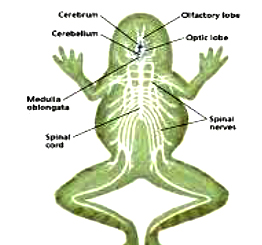About Lesson
NERVOUS SYSTEM:-
- The system for control and coordination is highly evolved in the frog. It includes both neural system and endocrine glands.
- The chemical coordination of various organs of the body is achieved by hormones, which are secreted by the endocrine glands.
- The prominent endocrine glands found in frog are pituitary, thyroid, parathyroid, thymus, pineal body, pancreatic islets, adrenals and gonads.
- The nervous system is organised into a central nervous system (brain and spinal cord), a peripheral nervous system (cranial and spinal nerves) and an autonomic nervous system (sympathetic and parasympathetic).
- There are ten pairs of cranial nerves arising from the brain.
- Brain is enclosed in a bony structure called brain box (cranium). The brain is divided into fore-brain, mid-brain and hind-brain.

- Forebrain includes olfactory lobes, paired cerebral hemispheres and unpaired diencephalon.
- The midbrain is characterised by a pair of optic lobes.
- Hind-brain consists of cerebellum and medulla oblongata.
- The medulla oblongata passes out through the foramen magnum and continues into spinal cord, which is enclosed in the vertebral column.
Join the conversation